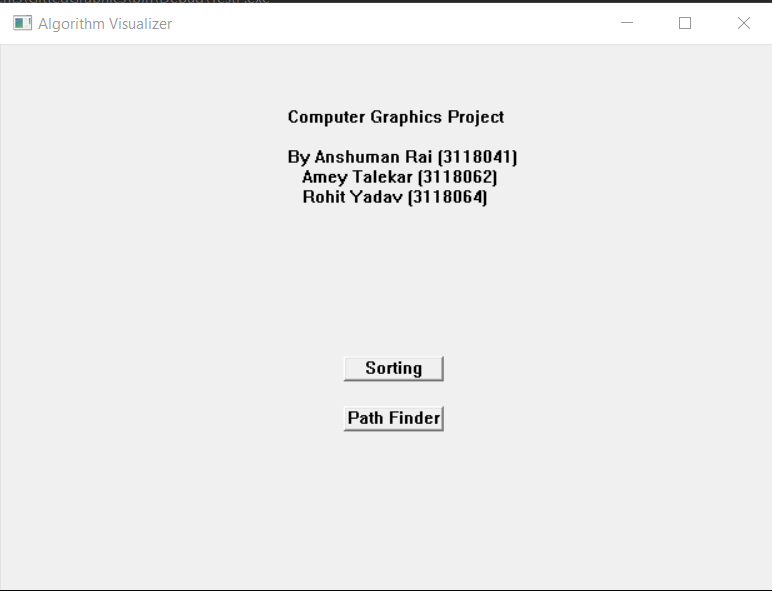Mini Project for the course "Computer Graphics" of semester-4 of B.E.
This is a visualizer for sorting and path finding algorithms made using C++/OpenGL
- Bubble Sort
- Selection Sort
- Insertion Sort
- Ripple Sort
- Dijkstra's
- A*
OpenGL
OpenGL is an open, cross-platform graphics standard with broad industry support. OpenGL greatly eases the task of writing real-time 2D or 3D graphics applications by providing a mature, well-documented graphics processing pipeline that supports the abstraction of current and future hardware accelerators.
The OpenGL Utility Library (GLU) contains several routines that use lower-level OpenGL commands to perform such tasks as setting up matrices for specific viewing orientations and projections, performing polygon tessellation, and rendering surfaces. This library is provided as part of every OpenGL implementation.
GLUT was written by Mark J. Kilgard, author of OpenGL Programming for the X Window System and The Cg Tutorial: The Definitive Guide to Programmable Real-Time Graphics, while he was working for Silicon Graphics Inc. The OpenGL Utility Toolkit (GLUT) is a library of utilities for OpenGL programs, which primarily perform system-level I/O with the host operating system. Functions performed include window definition, window control, and monitoring of keyboard and mouse input. Routines for drawing a number of geometric primitives (both in solid and wireframe mode) are also provided, including cubes, spheres and the Utah teapot. GLUT also has some limited support for creating pop-up menus.
Sorting
In computer science, a sorting algorithm is an algorithm that puts elements of a list in a certain order. The most frequently used orders are numerical order and lexicographical order. Efficient sorting is important for optimizing the efficiency of other algorithms (such as search and merge algorithms) that require input data to be in sorted lists. Sorting is also often useful for canonicalizing data and for producing human-readable output. More formally, the output of any sorting algorithm must satisfy two conditions: 1. The output is in nondecreasing order (each element is no smaller than the previous element according to the desired total order; ascending order). 2. The output is a permutation (a reordering, yet retaining all of the original elements) of the input.
Path finding
Pathfinding or pathing is the plotting, by a computer application, of the shortest route between two points. It is a more practical variant on solving mazes. This field of research is based heavily on Dijkstra's algorithm for finding the shortest path on a weighted graph. Pathfinding is closely related to the shortest path problem, within graph theory, which examines how to identify the path that best meets some criteria (shortest, cheapest, fastest, etc) between two points in a large network.
Note: Blue blocks -> Blocks searched already, Brown blocks -> obstacles and Green blocks -> Path found


